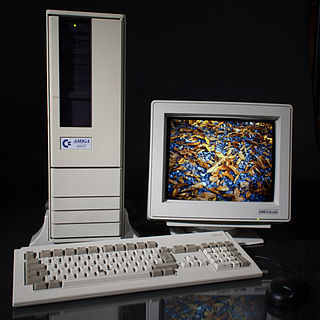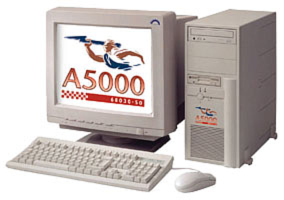
Phase5 Digital Products is a defunct German computer hardware manufacturer that developed third-party hardware primarily for the Amiga platform. Their most popular products included CPU upgrade boards, SCSI controllers and graphics cards.

Phase5 Digital Products is a defunct German computer hardware manufacturer that developed third-party hardware primarily for the Amiga platform. Their most popular products included CPU upgrade boards, SCSI controllers and graphics cards.
Like other third-party Amiga developers, Phase5 developed a range of CPU boards utilizing Motorola 68000 family processors, which powered Amiga systems at the time. Such boards also typically featured onboard RAM controllers with access to faster and greater capacity memory.
Notably, Phase5 were unique amongst Amiga developers in offering the Blizzard PPC and CyberStorm PPC products. These boards had a unique dual-CPU design utilizing both a Motorola 68k processor and a higher performance PowerPC processor. They operated in a novel fashion where both CPUs could execute concurrently while sharing the system address space. This architecture was enforced by the fact that AmigaOS was still 68k-based at the time and the required emulation software had not yet been developed to run natively on the PowerPC architecture. This design suffered from the need to flush CPU caches following context switches between 68k and PowerPC code. From a software development standpoint, this made mixing code ad hoc and often impractical. Minimizing such context switches required a large amount of effort and planning, making adoption of mixed binaries somewhat unpopular.
Phase5 developed a PowerPC kernel called PowerUP which ran alongside the 68k-based AmigaOS. Effectively, a programmer could then utilize the PowerPC CPU as a coprocessor. German company Haage & Partner developed a competing multi-tasking kernel called WarpOS for the Phase5 PowerPC boards which operated in a similar manner, but was not code-compatible with PowerUP.
The most common current reference to Phase5 is in the Linux port to APUS computer systems. Phase5 PowerPC boards are also able to run AmigaOS 4 and MorphOS.
Phase5 was founded in 1992 as subsidiary company of AS&S (Advanced Systems & Software) by Wolf Dietrich and Gerald Carda, which were the owners of AS&S. Phase5 focused on the development of general Amiga hardware, but mainly CPU boards, SCSI controllers and graphics cards.
The company Phase5 Elektronikfertigungs GmbH (hardware manufacturing) was founded in 1996 as a subsidiary, which produced all of the Phase5 expansions from that time on.
Following the initial PowerPC boards plans were announced on 22 July 1999 for new PowerPC boards based on the G3. These were to be developed with QNX Software Systems with the intention of building an alternative to the official Amiga solution of the time, to be known as AMIRAGE K2. [1] These products were never released.
On 9 February 2000 the company filed for insolvency and on 27 April 2000 the company was liquidated. DCE bought licenses before liquidation and produced some of the Phase5 hardware products under its own name. The A\Box, a concept for a complete computer scheduled for 1997 and based on custom chip technology, was planned but never released.
Much of Phase5's skill and experience was retained in a new company, bPlan GmbH, which in partnership with Genesi produced the Pegasos, a final realisation of several attempts to build an alternative Amiga system.

Amiga is a family of personal computers introduced by Commodore in 1985. The original model is one of a number of mid-1980s computers with 16- or 32-bit processors, 256 KB or more of RAM, mouse-based GUIs, and significantly improved graphics and audio compared to previous 8-bit systems. This includes the Atari ST—released earlier the same year—as well as the Macintosh and Acorn Archimedes. Based on the Motorola 68000 microprocessor, the Amiga differs from its contemporaries through the inclusion of custom hardware to accelerate graphics and sound, including sprites and a blitter, and a pre-emptive multitasking operating system called AmigaOS.

The Commodore Amiga 1000, also known as the A1000 and originally marketed as the Amiga, is the first personal computer released by Commodore International in the Amiga line. It combines the 16/32-bit Motorola 68000 CPU which was powerful by 1985 standards with one of the most advanced graphics and sound systems in its class, and runs a preemptive multitasking operating system that fits into 256 KB of read-only memory and shipped with 256 KB of RAM. The primary memory can be expanded internally with a manufacturer-supplied 256 KB module for a total of 512 KB of RAM. Using the external slot the primary memory can be expanded up to 8.5 MB.

PowerPC is a reduced instruction set computer (RISC) instruction set architecture (ISA) created by the 1991 Apple–IBM–Motorola alliance, known as AIM. PowerPC, as an evolving instruction set, has since 2006 been named Power ISA, while the old name lives on as a trademark for some implementations of Power Architecture–based processors.
OS-9 is a family of real-time, process-based, multitasking, multi-user operating systems, developed in the 1980s, originally by Microware Systems Corporation for the Motorola 6809 microprocessor. It was purchased by Radisys Corp in 2001, and was purchased again in 2013 by its current owner Microware LP.

The Amiga 2000, or A2000, is a personal computer released by Commodore in March 1987. It was introduced as a "big box" expandable variant of the Amiga 1000 but quickly redesigned to share most of its electronic components with the contemporary Amiga 500 for cost reduction. Expansion capabilities include two 3.5" drive bays and one 5.25" bay that could be used by a 5.25" floppy drive, a hard drive, or CD-ROM once they became available.
MorphOS is an AmigaOS-like computer operating system (OS). It is a mixed proprietary and open source OS produced for the Pegasos PowerPC (PPC) processor based computer, PowerUP accelerator equipped Amiga computers, and a series of Freescale development boards that use the Genesi firmware, including the Efika and mobileGT. Since MorphOS 2.4, Apple's Mac mini G4 is supported as well, and with the release of MorphOS 2.5 and MorphOS 2.6 the eMac and Power Mac G4 models are respectively supported. The release of MorphOS 3.2 added limited support for Power Mac G5. The core, based on the Quark microkernel, is proprietary, although several libraries and other parts are open source, such as the Ambient desktop.

The Commodore Amiga 4000, or A4000, is the successor of the A2000 and A3000 computers. There are two models: the A4000/040 released in October 1992 with a Motorola 68040 CPU, and the A4000/030 released in April 1993 with a Motorola 68EC030.
In computing, Quark is an operating system kernel used in MorphOS. It is a microkernel designed to run fully virtualized computers, called boxes. As of 2020, only one box is available, the ABox, that lets users run extant AmigaOS software compiled for Motorola 68000 series and PowerPC central processing units (CPUs).

The X68000 is a home computer created by Sharp Corporation. It was first released in 1987 and sold only in Japan. Gaming was a major use of the X68000, with custom sprite hardware and an 8-channel sound chip enabling ports of contemporaneous arcade video games.
This is a list of models and clones of Amiga computers.
The Amiga is a family of home computers that were designed and sold by the Amiga Corporation from 1985 to 1994.
AmigaOS is the proprietary native operating system of the Amiga personal computer. Since its introduction with the launch of the Amiga 1000 in 1985, there have been four major versions and several minor revisions of the operating system.

The Amiga 4000T, also known as A4000T, is a tower version of Commodore's A4000 personal computer. Using the AGA chipset, it was originally released in small quantities in 1994 with a 25 MHz Motorola 68040 CPU, and re-released in greater numbers by Escom in 1995, after Commodore's demise, along with a new variant which featured a 50 MHz Motorola 68060 CPU. Despite the subsequent demise of Escom, production was continued by QuikPak in North America into at least 1997.
Hombre is a RISC chipset for the Amiga, designed by Commodore, which was intended as the basis of a range of Amiga personal computers and multimedia products, including a successor to the Amiga 1200, a next generation game machine called CD64 and a 3D accelerator PCI card. Hombre was canceled along with the bankruptcy of Commodore International.
WarpOS is a multitasking kernel for the PowerPC (PPC) architecture central processing unit (CPU) developed by Haage & Partner for the Amiga computer platform in the late 1990s and early 2000s. It runs on PowerUP accelerator boards developed by phase5 which contains both a Motorola 68000 series CPU and a PowerPC CPU with shared address space. WarpOS runs alongside the 68k-based AmigaOS, which can use the PowerPC as a coprocessor. Despite its name, it is not an operating system (OS), but a kernel; it supplies a limited set of functions similar to those in AmigaOS for using the PowerPC. When released, its original name was WarpUP, but was changed to reflect its greater feature set, and possibly to avoid comparison with its competitor, PowerUP.

The Amiga 1200, or A1200, is a personal computer in the Amiga computer family released by Commodore International, aimed at the home computer market. It was launched on October 21, 1992, at a base price of £399 in the United Kingdom and $599 in the United States.

The Power A5000 was a planned Amiga clone computer, announced by DCE and Power Computing. It was one of the first Amiga clone computers announced after Gateway purchased the Amiga in 1997.

PowerUP boards were dual-processor accelerator boards designed by Phase5 Digital Products for Amiga computers. They had two different processors, a Motorola 68000 series (68k) and a PowerPC, working in parallel, sharing the complete address space of the Amiga computer system.

Haage & Partner is a German company established in 1995. The company distributes software products where they usually are the exclusive distributor. Products are aimed at Microsoft Windows and Mac OS, and has been aimed at AmigaOS in the past. The primary destination countries are Germany, Austria, and Switzerland.

A new version of AmigaOS was released on December 24, 2006 after five years of development by Hyperion Entertainment (Belgium) under license from Amiga, Inc. for AmigaOne registered users.